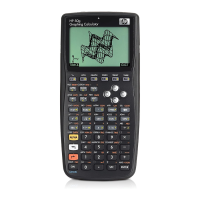Page 16-20
Example 3 – Consider the equation
d
2
y/dt
2
+y = δ(t-3),
where δ(t) is Dirac’s delta function.
Using Laplace transforms, we can write:
L{d
2
y/dt
2
+y} = L{δ(t-3)},
L{d
2
y/dt
2
} + L{y(t)} = L{δ(t-3)}.
With ‘
Delta(X-3)’ ` LAP , the calculator produces EXP(-3*X), i.e., L{δ(t-3)}
= e
–3s
. With Y(s) = L{y(t)}, and L{d
2
y/dt
2
} = s
2
⋅Y(s) - s⋅y
o
– y
1
, where y
o
= h(0)
and y
1
= h’(0), the transformed equation is s
2
⋅Y(s) – s⋅y
o
– y
1
+ Y(s) = e
–3s
. Use
the calculator to solve for Y(s), by writing:
‘X^2*Y-X*y0-y1+Y=EXP(-3*X)’ ` ‘Y’ ISOL
The result is ‘Y=(X*y0+(y1+EXP(-(3*X))))/(X^2+1)’.
To find the solution to the ODE, y(t), we need to use the inverse Laplace
transform, as follows:
OBJ ƒ ƒ Isolates right-hand side of last expression
ILAP μ Obtains the inverse Laplace transform
The result is ‘y1*SIN(X)+y0*COS(X)+SIN(X-3)*Heaviside(X-3)’.
Note: Using the two examples shown here, we can confirm what we indicated
earlier, i.e., that function ILAP uses Laplace transforms and inverse transforms to
solve linear ODEs given the right-hand side of the equation and the
characteristic equation of the corresponding homogeneous ODE.

